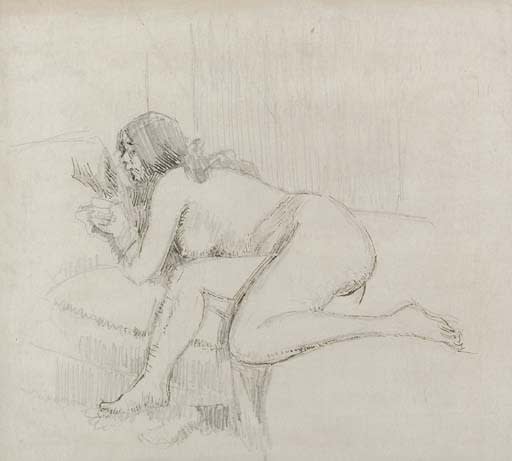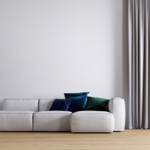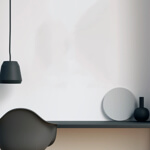Walter Richard Sickert 1860-1942
Reclining Nude on a Bed
Pencil, ink and pen on paper
27 x 30.2 cms
10 10/16 x 11 14/16 ins
10 10/16 x 11 14/16 ins
701
Sold
Sickert's approach to drawing was pragmatic and the results extremely varied. He was not afraid to experiment, just as in his writing he was not averse to changing his mind....
Sickert's approach to drawing was pragmatic and the results extremely varied. He was not afraid to experiment, just as in his writing he was not averse to changing his mind. Before embarking on a painting he would make countless drawings before a model or on site. Often on scraps of paper, he had a disregard for his materials that bordered on the reckless. A drawing was apparently little more than a working tool, certainly not something about which to be too precious and his numerous drawings are often on the flimsiest of paper. Whether thick or thin, rough or smooth, white or coloured, Sickert would use whatever was to hand, even envelopes and brown paper bags.
Whilst Sickert's repertoire of subjects may have gained followers, his radicalism has also gained admirers even from artists whose work is fundamentally different. Frank Auerbach, for example, whilst emphasising that is not the slightest attempt to emulate or follow Sickert or the Camden Town School' (1), has also written of his admiration for the artist, characterising him as immensely experimental, abstract minded, inventive, systematising draughtsman.' (2)
Reclining Nude on a Bed well illustrates Sickert's improvisatory approach, and although it is extremely hard to date, comparison with other drawings that combine pencil and ink in this way suggest that it was done around 1914-15.
Demonstrating the central importance of the female figure, whether clothed or unclothed in Sickert's art of this period, this drawing illustrates the way that he often radically reworked his own drawings, often using dark ink over fine pencil, or bold crayon over delicate sanguine. It is surely significant that Sickert was an active teacher, for such self-criticism resembles that of an art teacher correcting the work of a student.
Reclining Nude on a Bed a rapidly executed initial sketch in pencil, already shows signs of modification, as in the shifting positions of the subject's hands and feet. Ink is then used to rework this pencil drawing still further, overlaying the fluid lines of pencil with short precise lines of ink that are more staccato in movement.
1. Frank Auerbach, unpublished interview with JH, July 1990
2. Frank Auerbach, unpublished letter to JH, 18 June 1992
Whilst Sickert's repertoire of subjects may have gained followers, his radicalism has also gained admirers even from artists whose work is fundamentally different. Frank Auerbach, for example, whilst emphasising that is not the slightest attempt to emulate or follow Sickert or the Camden Town School' (1), has also written of his admiration for the artist, characterising him as immensely experimental, abstract minded, inventive, systematising draughtsman.' (2)
Reclining Nude on a Bed well illustrates Sickert's improvisatory approach, and although it is extremely hard to date, comparison with other drawings that combine pencil and ink in this way suggest that it was done around 1914-15.
Demonstrating the central importance of the female figure, whether clothed or unclothed in Sickert's art of this period, this drawing illustrates the way that he often radically reworked his own drawings, often using dark ink over fine pencil, or bold crayon over delicate sanguine. It is surely significant that Sickert was an active teacher, for such self-criticism resembles that of an art teacher correcting the work of a student.
Reclining Nude on a Bed a rapidly executed initial sketch in pencil, already shows signs of modification, as in the shifting positions of the subject's hands and feet. Ink is then used to rework this pencil drawing still further, overlaying the fluid lines of pencil with short precise lines of ink that are more staccato in movement.
1. Frank Auerbach, unpublished interview with JH, July 1990
2. Frank Auerbach, unpublished letter to JH, 18 June 1992




